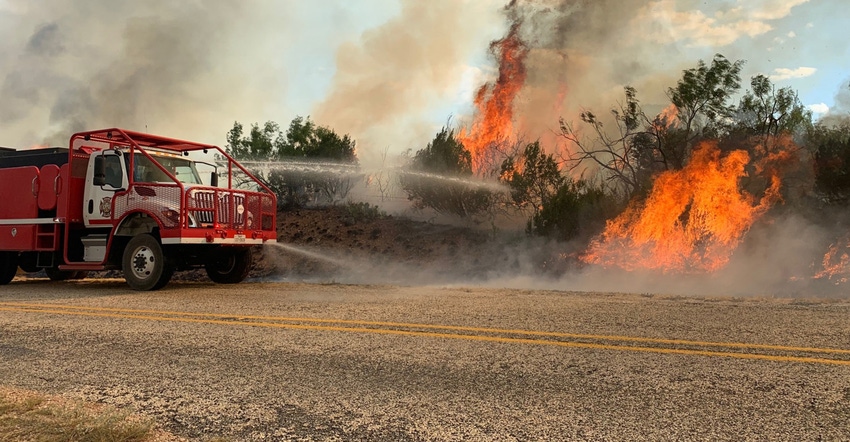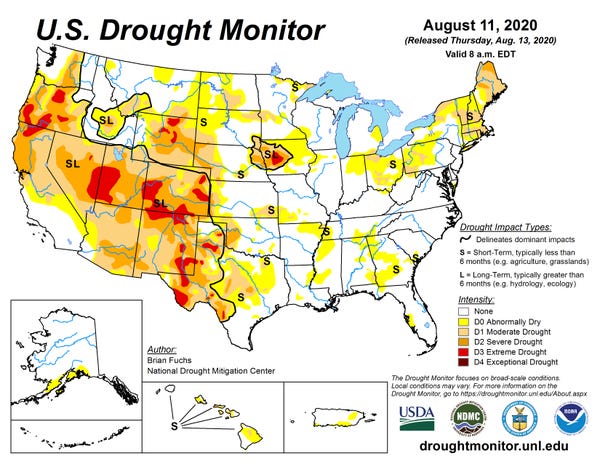August 14, 2020

Dry conditions across much of Texas coupled with triple-digit temperatures have resulted in increased wildfire activity, particularly in north-central Texas and in areas along the Interstate-35 corridor. Conducive wildfire conditions are also expanding north and east into higher population centers, including the Interstate-45 corridor.
“We are seeing a significant increase in wildfire occurrence that coincides with the current streak of 100-degree days,” said Brad Smith, Texas A&M Forest Service predictive services department head. “Many of these wildfires are starting late in the day, or early evening, when we observe daily peak heating and an increase in gusty winds.”

A cold front forecasted to move into the state early next week will likely end the streak of 100-degree days. However, the front is not expected to provide enough rainfall to improve the vegetative dryness that is supporting wildfire activity.
For current conditions and wildfire outlook, check out the Texas Fire Potential Outlook.
Fires burned 5,483 Texas acres this week; many fires preventable
Over the past seven days, state and local resources have responded to 94 fires that burned 5,483 acres. This includes large, multi-day fires such as the still-smoldering Pennington Creek Fire in Palo Pinto and Jack counties, which has burned 2,654 acres and is 95% contained. Activity in Central Texas increased this week with new fires in Brown, Mills, Caldwell, Williamson, and Bastrop counties.
Many recent wildfires have been attributed to preventable human activities such as debris burning. In 2020 so far, debris burning has caused 902 wildfires, which burned 10,994 acres. This includes 16 fires that have burned 104 acres over the past week.
Aviation resources continue to assist ground crews by dropping water and fire retardants to slow fire progression. Fire suppression aircraft have logged approximately 87 hours of flight time over the past week. Efforts involved dropping 148,240 gallons of water and 33,697 gallons of retardant on multiple fires, including the Pennington Creek Fire, the Smith Fire in Mills County (252 acres, 80% contained) and the All Hands Fire in Coleman County (619 acres, 100% contained).
Aviation resources include two Type 1 helicopters, two Type 3 helicopters, nine single engine air tankers, one heavy air tanker and two air attack platforms.
Since Jan. 1, 2020, state and local resources have responded to 3,330 fires that burned a total of 171,204 acres. Aviation resources have flown 1,510 hours, dropping 1,517,151 gallons of water and retardant on Texas wildfires.
Prevention and mitigation
The majority of wildfires in Texas are caused by humans. With hot and dry conditions statewide, many counties in Texas are currently under a burn ban. During periods of drought or high wildfire danger, a county judge or commissioner’s court may enact a burn ban to protect the public and prevent human-caused wildfires.
“Across Texas, we are experiencing a hot and dry weather pattern, which is creating critically dry fuels that are highly susceptible to ignition,” stated Karen Stafford, Texas A&M Forest Service prevention program coordinator. “Texas A&M Forest Service is reminding residents to be mindful of any outdoor activity that may cause a spark.”
Here are some things to know before you burn any debris:
Learn before you burn. Contact your county officials to ensure your county is not currently under a burn ban or other outdoor burning restrictions.
Many areas of Texas are experiencing high temperatures and dry weather. Residents should stay up to date on weather conditions and always use extreme caution when performing these outdoor activities even if not under a burn ban.
Always obey local burn bans and outdoor burning restrictions. Wait to conduct any outdoor burning or light campfires until the burn ban has been lifted and weather conditions are not extremely hot, dry, or windy.
When burning debris, choose a day when winds are under 10 mph and humidity is high in your area.
Keep the debris pile small and have a 10-foot area cleared around the pile. Always keep a water source nearby.
Residents should pay attention to county burn bans and avoid all outdoor burning until conditions improve. Burn ban information can be found by contacting local fire departments or by visiting Texas Burn Bans.
Source: is AgriLife TODAY, which is solely responsible for the information provided and is wholly owned by the source. Informa Business Media and all its subsidiaries are not responsible for any of the content contained in this information asset.
Read more about:
WildfiresYou May Also Like




